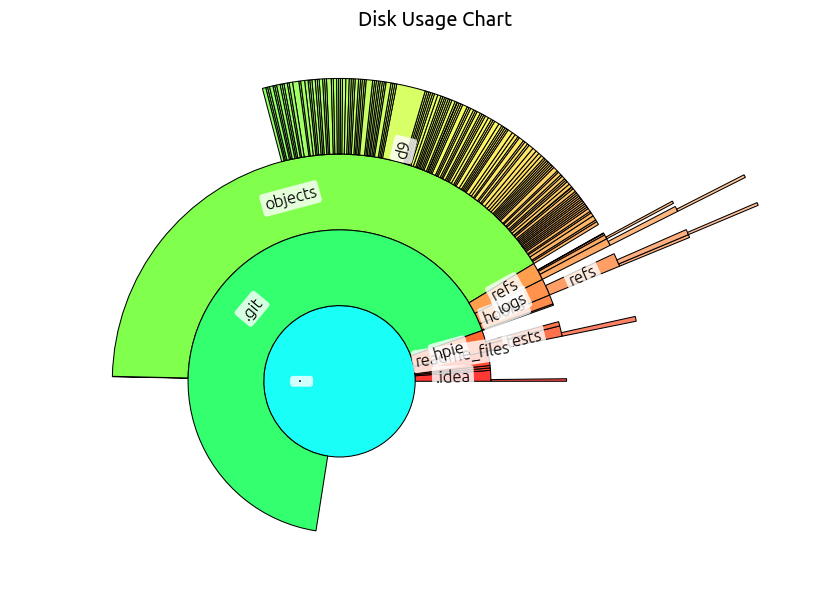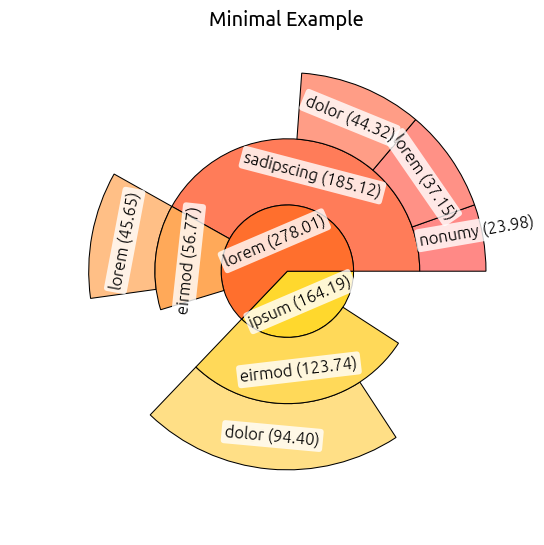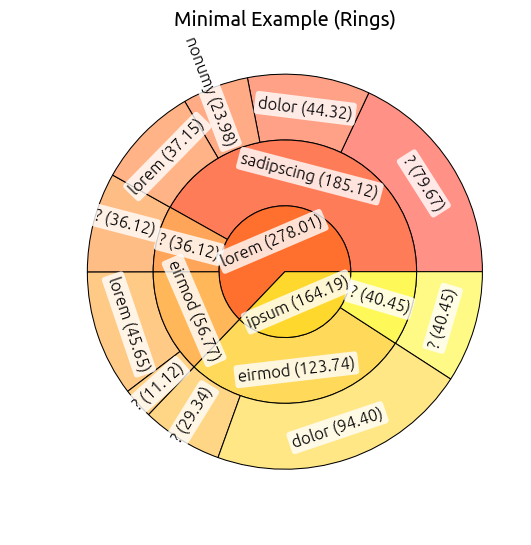Use matplotlib to plot sunburst charts/hierarchical pie charts/ring charts/multilevel pie charts (as e.g. in disk usage diagrams).
Project description
Sunburst Charts
🔖 Check out the full documentation!
Introduction
sunburst is a module to create "Ring charts" or "Hierarchical Pie
Charts" (also called "Multilevel Pie Charts" or "Sunburst Charts") together with the matplotlib package. Quoting
Wikipedia:
A ring chart, also known as a sunburst chart or a multilevel pie chart, is used to visualize hierarchical data, depicted by concentric circles. The circle in the centre represents the root node, with the hierarchy moving outward from the center. A segment of the inner circle bears a hierarchical relationship to those segments of the outer circle which lie within the angular sweep of the parent segment.
A prominent example are disk usage charts (see
examples/disk_usage_plot.py for this example):
✨ Features
sunburst tries to be
- Intuitive & Easy to use: After setting up your data and
matplotlib, not more than two lines are necessary to generate first plots (minimal example). - Flexible & Robust: Wherever it makes sense, the methods of the
SunburstPlotclass are intended to be overwritten. Methods that are responsible for spacing, coloring, styling etc. of thewedgestake the corresponding data point (path) as an argument, allowing to set most properties independently for eachwedge.
More specifically:
- Clever positioning of labels, which - depending on space constraints are positioned in a tangentially or radially.
- An easy way to "explode" the plot by redefining
sunburst.wedge_spacing(example, example).
📦 Installation
To install, run
pip3 install sunburst
🚧 Migration notice
For the first release to pypi, this package has been rebranded as
sunburst. This includes non-backwards compatible changes to the API: Most importantly, the HPie class is now SunburstPlot and many other
changes.
To get the old version back, check out the old-hpie branch.
🔥 Minimal example
You can find several examples at examples/. The most basic example is
minimal_example_sunburst.py:
import matplotlib.pyplot as plt
from sunburst import SunburstPlot, stringvalues_to_pv
# set up some data
data = stringvalues_to_pv({
'ipsum': 40.45,
'ipsum/eirmod': 29.34,
'ipsum/eirmod/dolor': 94.4,
'lorem': 36.12,
'lorem/sadipscing/dolor': 44.32,
'lorem/sadipscing/lorem': 37.15,
'lorem/sadipscing/nonumy': 23.98,
'lorem/eirmod': 11.12,
'lorem/eirmod/lorem': 45.65,
'lorem/sadipscing': 79.67,
})
fig, ax = plt.subplots()
sbp = SunburstPlot(data, ax)
sbp.plot(setup_axes=True)
ax.set_title('Example SunburstPlot')
plt.show()
Running this script with python3 minimal_example_sunburst.py will
produce the following plot:
The Data
Note that the value corresponding to path is always the value
excluding the values of the children of the path. Therefore plotting
the SunburstPlot object computes a "completed" version of the
"pathvalue dictionary". You can check this with the
SunburstPlot._completed_pv instance variable which gets initialized
after calling SunburstPlot.plot(*args). Running our minimal example
prints the following:
sbp._completed_pv.items() = {
Path((, )): 442.2, # = the total sum of all items =
# = 36.12 + 44.32 + 37.15 + 23.98 + ...
Path(('ipsum', )): 164.19000000000003, # = sum of "ipsum" and all of its children =
# = 40.45 + 29.34 + 94.4
Path(('ipsum', 'eirmod', )): 123.74000000000001, # = sum of ipsum/eirmod and all of its children =
# = 29.34 + 94.4
Path(('ipsum', 'eirmod', 'dolor', )): 94.4,
Path(('lorem', )): 278.01,
Path(('lorem', 'eirmod', )): 56.769999999999996,
Path(('lorem', 'eirmod', 'lorem', )): 45.65,
Path(('lorem', 'sadipscing', )): 185.12,
Path(('lorem', 'sadipscing', 'dolor', )): 44.32,
Path(('lorem', 'sadipscing', 'lorem', )): 37.15,
Path(('lorem', 'sadipscing', 'nonumy', )): 23.98,
}
sunburst/tests/test_calc.py contains an explicit test of this
calculation based on a similar example.
Ring Charts
Thus you get ring charts, if and only if all of the non-zero values correspond to paths with the same length. E.g. if we change the above data as follows (by lengthening the paths with question marks and removing the entry for the empty path):
data = stringvalues_to_pv({
'ipsum/?/?': 40.45,
'ipsum/eirmod/?': 29.34,
'ipsum/eirmod/dolor': 94.4,
'lorem/?/?': 36.12,
'lorem/sadipscing/dolor': 44.32,
'lorem/sadipscing/lorem': 37.15,
'lorem/sadipscing/nonumy': 23.98,
'lorem/eirmod/?': 11.12,
'lorem/eirmod/lorem': 45.65,
'lorem/sadipscing/?': 79.67,
})
we should get a classical ring chart. This is
minimal_example_rings.py. Running it via
python3 minimal_example_rings.py yields the following plot, which
indeed just fills up the white space of the above plot with wedges
labeled ?.
License
This project is licensed under the BSD 3-Clause License, see
LICENSE.txt.
Project details
Release history Release notifications | RSS feed
Download files
Download the file for your platform. If you're not sure which to choose, learn more about installing packages.
Source Distribution
Built Distribution
File details
Details for the file sunburst-1.0.0a2.tar.gz.
File metadata
- Download URL: sunburst-1.0.0a2.tar.gz
- Upload date:
- Size: 22.0 kB
- Tags: Source
- Uploaded using Trusted Publishing? No
- Uploaded via: twine/3.4.2 importlib_metadata/4.6.3 pkginfo/1.7.1 requests/2.26.0 requests-toolbelt/0.9.1 tqdm/4.62.0 CPython/3.9.6
File hashes
| Algorithm | Hash digest | |
|---|---|---|
| SHA256 |
47379fe2ca389a011d436debcded8d08defd2cf2c4c01ac2a5201752c9cd4a32
|
|
| MD5 |
e58f4238d5de808fe60222a3ff5a1838
|
|
| BLAKE2b-256 |
0d9e3d829ea59b8b5e6739ed72b242d9794af65ae6ec7d8ecd0c0ada05f84c04
|
File details
Details for the file sunburst-1.0.0a2-py3-none-any.whl.
File metadata
- Download URL: sunburst-1.0.0a2-py3-none-any.whl
- Upload date:
- Size: 28.2 kB
- Tags: Python 3
- Uploaded using Trusted Publishing? No
- Uploaded via: twine/3.4.2 importlib_metadata/4.6.3 pkginfo/1.7.1 requests/2.26.0 requests-toolbelt/0.9.1 tqdm/4.62.0 CPython/3.9.6
File hashes
| Algorithm | Hash digest | |
|---|---|---|
| SHA256 |
83bb1c4af1353ac9348b88109f590f922ae47220ad15b3e60ec8bf6aa201e4c2
|
|
| MD5 |
f67afb6ae1024a94143f4e91a65ba66b
|
|
| BLAKE2b-256 |
f0959a32297aaad73ab14be7f81bc28924d0bf8b23788f1e1199e5867124ed3c
|



















